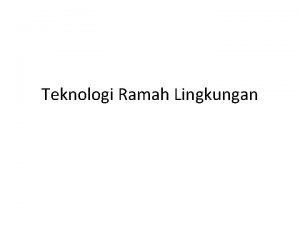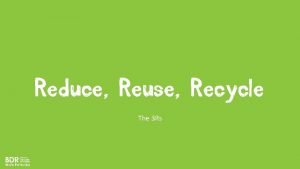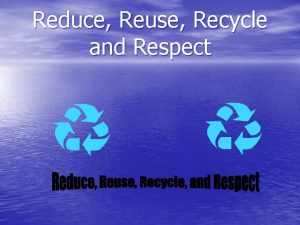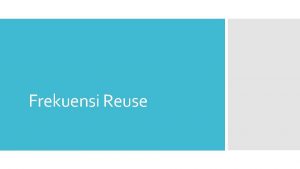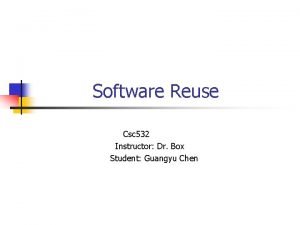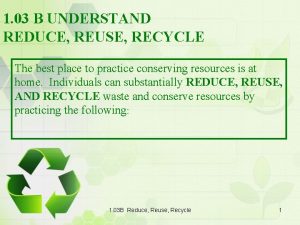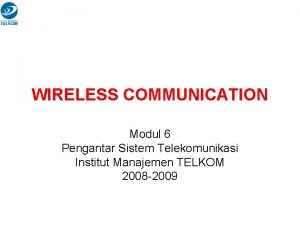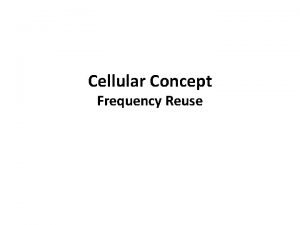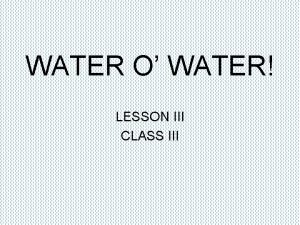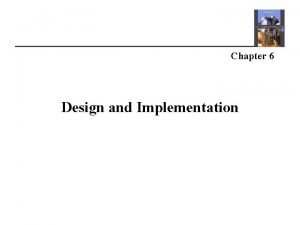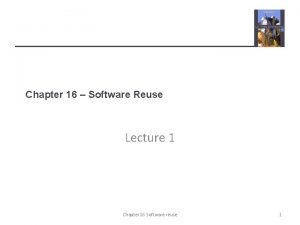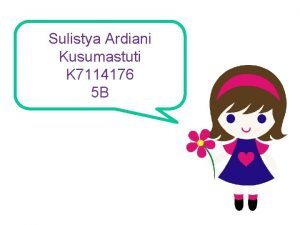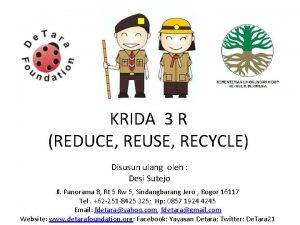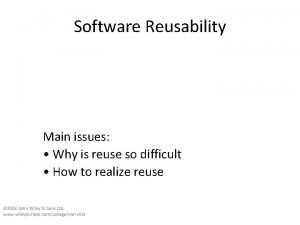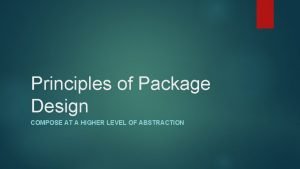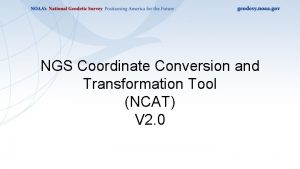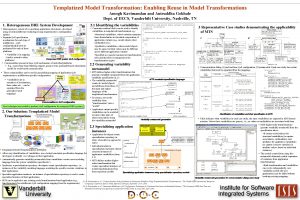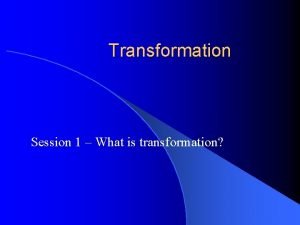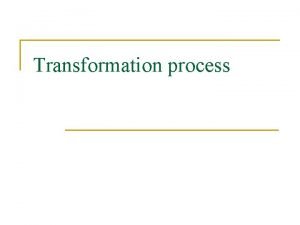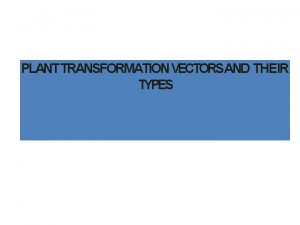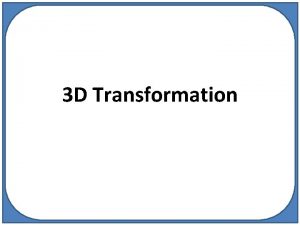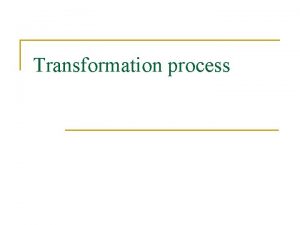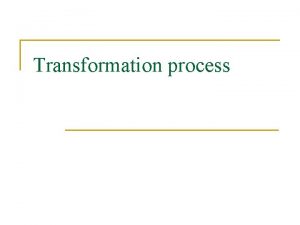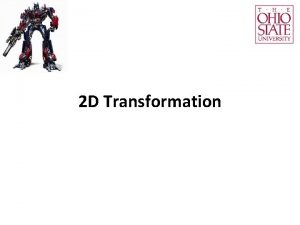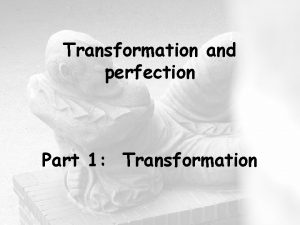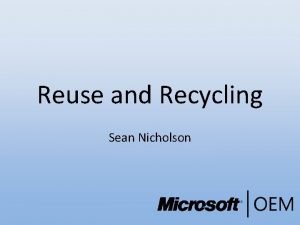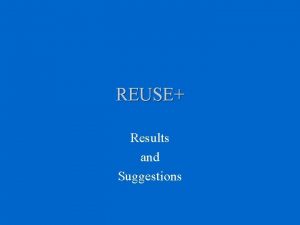Supporting Tool Reuse with Model Transformation Zekai Demirezen









![The Dot-GMF Interoperability graph "default. umlclass_diagram" { { node [label="N"]; Class 1; Class 2; The Dot-GMF Interoperability graph "default. umlclass_diagram" { { node [label="N"]; Class 1; Class 2;](https://slidetodoc.com/presentation_image/569a965b82a82edea921fa9df17cfc27/image-10.jpg)









- Slides: 19

Supporting Tool Reuse with Model Transformation Zekai Demirezen 1, Yu Sun 1, Frédéric Jouault 2, Jeff Gray 1 1 Department of Computer and Information Sciences, University of Alabama at Birmingham {zekzek, yusun, gray}@cis. uab. edu 2 Atlan. Mod (INRIA & EMN) frederic. jouault@inria. fr SEDE 2009– June 22 - 24, 2009 -Las Vegas, Nevada This work funded in part by NSF CAREER award CCF-0643725.

Outline Introduction Tool Interoperability Approaches to Tool Interoperability Model Transformation Solution Amm. A Platform Case Study: Reusing Graphviz/Dot Layout Algorithm in GMF Layout in Graphviz/Dot Graphical Modeling Framework GMF – Dot Transformation (KM 3, ATL, and TCS Specifications) Video Demonstration Lessons Learned & Conclusion SEDE 2009– June 22 - 24, 2009 -Las Vegas, Nevada

Tool Interoperability HOW? ? ? Reuse functionality Software A Software B tools provide • Binary Data • XML Data (Export-Import Mechanism) • API support SEDE 2009– June 22 - 24, 2009 -Las Vegas, Nevada

Approaches to Tool Interoperability Software A Supports Meta. Data Interchange (XMI) Software B Solution Supports Meta. Data Interchange (XMI) Basic and easy solution Supports Export/Import Supports XML Data Export/Import XML Data Requires XML Transformation such as XSLT or Meta. Model Transformation Provide API Programming in general-purpose language Binary Data Programming in general-purpose language or Meta. Model Transformation SEDE 2009– June 22 - 24, 2009 -Las Vegas, Nevada

Model Transformation Approach Software A Software B Meta. Model Definition Transformation Definition • Based on meta Elements • Reusable and maintainable solution Execute Functionality SEDE 2009– June 22 - 24, 2009 -Las Vegas, Nevada

Amm. A Platform Amm. A (Atlas Model Management Architecture) provides model management and transformation tools. Amm. A offers three core facilities : The KM 3 (Kernel Meta. Model) to define metamodels. The TCS (Textual Concrete Syntax) language to define representation syntax. The ATL (Atlas Transformation Language) to define transformation rules which map meta-elements. SEDE 2009– June 22 - 24, 2009 -Las Vegas, Nevada

Case Study: Reusing Graphviz/Dot Layout Algorithm in Graphical Modeling Framework Using the Graphviz/Dot auto-layout algorithm for usage on UML class diagrams in GMF. SEDE 2009– June 22 - 24, 2009 -Las Vegas, Nevada

Layout in Graph. Viz is an open source graph visualization application that has several layout programs for the placement of nodes and edges in graphs. SEDE 2009– June 22 - 24, 2009 -Las Vegas, Nevada

Graphical Modeling Framework • The Eclipse Graphical Modeling Framework (GMF) provides a supporting infrastructure for developing graphical editors based on Eclipse Modeling Framework. • Models in GMF are defined by an Ecore metamodel. Diagram, (e. g. , Class Diagram) Node (e. g. , Class) Edge (e. g, , Association) SEDE 2009– June 22 - 24, 2009 -Las Vegas, Nevada
![The DotGMF Interoperability graph default umlclassdiagram node labelN Class 1 Class 2 The Dot-GMF Interoperability graph "default. umlclass_diagram" { { node [label="N"]; Class 1; Class 2;](https://slidetodoc.com/presentation_image/569a965b82a82edea921fa9df17cfc27/image-10.jpg)
The Dot-GMF Interoperability graph "default. umlclass_diagram" { { node [label="N"]; Class 1; Class 2; Class 3; Class 4; graph [bb="0, 0, 150, 252"]; Class 4 -- Class 1; Class 1 [pos="29, 234", width="0. 81", height="0. 50"]; Class 3 -- Class 2; Alignment Class 2 [pos="118, 234", width="0. 89", height="0. 50"]; Class 3 -- Class 1; Class 3 [pos="99, 18", width="0. 78", height="0. 50"]; } Class 4 [pos="69, 90", width="0. 89", height="0. 50"]; Class 1 -- Class 4 [pos="38, 217 44, 206 53, 191 59, 180"]; Class 3 -- Class 1 [pos="106, 217 98, 206 88, 191 81, 179"]; Class 2 -- Class 3 [pos="26, 216 23, 197 20, 167 28, 144 33, 129 44, 116 53, 106"]; } SEDE 2009– June 22 - 24, 2009 -Las Vegas, Nevada

The Dot-GMF Interoperability Implementation SEDE 2009– June 22 - 24, 2009 -Las Vegas, Nevada

The Dot-GMF Interoperability Implementation 1. 2. 3. 4. Defining Graphviz/Dot Metamodel as Dot. km 3 (Note: GMF metamodel already exists) Defining Dot Concrete Syntax (Dot. tcs) to Export GMF models as models in Dot Import Dot Models as GMF Models after the execution of auto layout algorithm Defining Transformation of GMF Models to Dot Models with using ATL (Notation 2 Dot. atl) Defining Merge Transformation of source and output models (arranged model) with ATL. (Merge. Dot. Position. Into. Notation. atl) SEDE 2009– June 22 - 24, 2009 -Las Vegas, Nevada

Graphviz/Dot Metamodel (Dot. km 3) --Node statement class Node extends Graph. Element { attribute name : String; abstract class Graph Edge class extends Graph. Element Located. Element extends {{ { Located. Element { Node reference attr_list[*] container: reference is. Directed owner left : Node; : Graph : Boolean; opposite. Of elements; attribute name : String; A_Item_List; } } attribute name reference right : Node; String; attr_list[*] container: A_Item_List; --Ege statement referenceis. Directed attribute elements[*] : Boolean; container : Graph. Element } class Edge extends Graph. Element { opposite. Of reference owner; attr_list[*] container: A_Item_List; reference left : Node; class Graph extends Located. Element reference right : Node; } { attribute is. Directed : Boolean; reference attr_list[*] container: attribute name : String; A_Item_List; reference elements[*] container : } Graph. Element opposite. Of owner; --Attribute statement } class Attribute extends Graph. Element { abstract class Graph. Element reference attr_list[*] container: extends Located. Element { A_Item_List; } reference owner : Graph opposite. Of elements; SEDE 2009– June 22 - 24, 2009 -Las Vegas, Nevada

Dot Concrete Syntax(Dot. tcs) template Graph main context : (is. Directed ? "digraph" : "graph" ) name "{" elements {separator = "; "} [[ "; " | ]] "}" ; template Graph. Element abstract ; digraph G { template abstract book Attr_Stmt [shape=box]; ; book -> title [style=dotted]; book -> author ; template Node add. To. Context book -> content [weight=8]; : name attr_list content -> chapter; ; content -> appendix; template Edge chapter -> section[color=red]; : left{refers. To = name, auto. Create = section [shape=box, style=filled, ifmissing, create. In = '#context'. elements} (is. Directed ? color=blue]; "->" : "--") right{refers. To = name, auto. Create = } template Edge_Attr_Stmt context : "edge" attr_list ; template Graph_Attr_Stmt context : "graph" attr_list ; template Node_Attr_Stmt context : "node" attr_list ; template A_Item_List context : "[" a_item_list {separator = ", " } "]" ; template A_Item context : left. ID (is. Defined(right. ID)? "="right. ID) ; ifmissing, create. In = '#context'. elements} attr_list ; SEDE 2009– June 22 - 24, 2009 -Las Vegas, Nevada

Transformation of GMF Models to Dot Models (Notation 2 Dot. atl) module Notation 2 Dot; rule Node 2 Node{ create OUT : Dot from IN : notation; from rule Diagram 2 Graph{ n : notation!Node ( from n. type ='2001' d : notation!Diagram ) to to g : Dot!Graph ( c : Dot!Node ( name <- d. name, name <- n. element. name. debug('Node name') elements <- d. children) >union(d. edges) ) rule Edge 2 Edge{ from n : notation!Edge ( n. type = '4005' ) to c : Dot!Edge ( left <- n. source, right <- n. target ) SEDE 2009– June 22 - 24, 2009 -Las Vegas, Nevada rule Edge 2 Edge{ Node 2 Node{ Diagram 2 Graph{ from n notation!Node ( d : notation!Edge notation!Diagram n. type ='2001' n. type = '4005' to )g : Dot!Graph ( to name <- d. name, c elements : Dot!Edge Dot!Node <-(d. children->union(d. edges) name <leftn. element. name. debug('Node <- n. source, name') ) ) right <- n. target )

Merge Position Values into GMF Model (Merge. atl) create out. Diagram : notation refining in. Diagram : notation, IN : Dot; helper context notation!Bounds def: dot. Position : Tuple. Type(x : String, y : String, w: String, let data: Set(Dot!Node)= Dot!Graph. all. Instances()for(b in notation!Bounds. all. Instances()) { h: String) = >first(). elements let data: Set(Dot!Node)= Dot!Graph. all. Instances()->first(). elements b. x <- b. dot. Position. x. to. Integer(); ->select(e| e. ocl. Is. Type. Of(Dot!Node)) b. y <b. dot. Position. y. to. Integer(); ->select(e| e. name=self. ref. Immediate. Composite(). element. name) ->select(e| }In let data 2: Set(Dot!A_Item)=data->first(). attr_list->first(). a_item_list in e. name=self. ref. Immediate. Composite(). element. name) Tuple{ x=data 2 ->select(e| e. left. ID='pos'). first(). right. ID. split(', ')->first(), y=data 2 ->select(e| e. left. ID='pos'). first(). right. ID. split(', ')->last(), In let data 2: Set(Dot!A_Item)=data->first(). attr_listw=data 2 ->any(e| e. left. ID='width'). right. ID, >first(). a_item_list in h=data 2 ->select(e| e. left. ID='height'). last(). right. ID Tuple{ }. debug('tuple'); x=data 2 ->select(e| e. left. ID='pos'). first(). right. ID. split(', ')entrypoint rule Main() { do { >first(), for(b in notation!Bounds. all. Instances()) { y=data 2 ->select(e| e. left. ID='pos'). first(). right. ID. split(', ')b. x <- b. dot. Position. x. to. Integer(); >last(), b. y <- b. dot. Position. y. to. Integer(); } w=data 2 ->any(e| e. left. ID='width'). right. ID, SEDE 2009– June 22 - 24, 2009 -Las Vegas, Nevada h=data 2 ->select(e| e. left. ID='height'). last(). right. ID

Demo SEDE 2009– June 22 - 24, 2009 -Las Vegas, Nevada

Lessons Learned & Conclusion This study shows software interoperability which is based on Model Transformation technique. Model Transformation provides a reusable, maintainable solution for interoperability. Model transformation, enables us to focus on the clear and organized mapping structure between metaelements of the tools. Amm. A shows good performance. Although it provides most of the basic model activities such as load, edit, build, store, and execution, lack of debugging makes it hard to identify errors. SEDE 2009– June 22 - 24, 2009 -Las Vegas, Nevada

Thanks Questions & Comments ? SEDE 2009– June 22 - 24, 2009 -Las Vegas, Nevada
 Tujuan teknologi ramah lingkungan
Tujuan teknologi ramah lingkungan 3 benefits of recycling
3 benefits of recycling 3r
3r Objectives of reuse reduce recycle
Objectives of reuse reduce recycle Reduce reuse recycle respect
Reduce reuse recycle respect Frekuensi reuse
Frekuensi reuse Advantages of reuse
Advantages of reuse Make a poster reduce reuse recycle
Make a poster reduce reuse recycle Reuse distance
Reuse distance Reuse dialyzer
Reuse dialyzer Frequency reuse distance formula
Frequency reuse distance formula Bee green recycling
Bee green recycling Water o water
Water o water Implementation in software engineering
Implementation in software engineering Cots reuse
Cots reuse Sikap apa yang bisa dicontoh dari pengrajin barang bekas
Sikap apa yang bisa dicontoh dari pengrajin barang bekas Reuse adalah
Reuse adalah Software reuse
Software reuse Stable abstractions principle
Stable abstractions principle Ngs coordinate conversion and transformation tool (ncat)
Ngs coordinate conversion and transformation tool (ncat)
